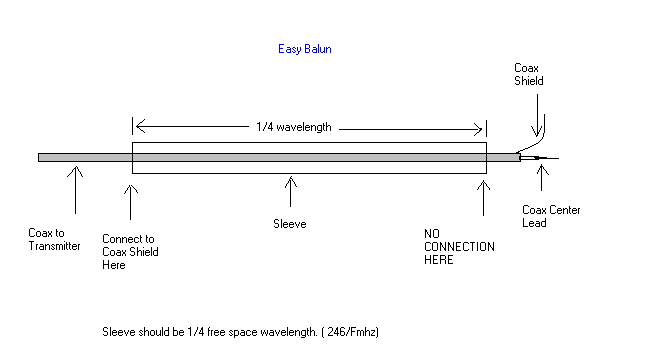Easy Balun
2 Meter Balun
A simple and effective sleeve type balun is easily built.
Cut a 22 inch length of coax. Remove the outer insulation completely. By pushing the shield wire toward
the center it will expand like the old finger puzzles. Remove the shield wire. This will become the sleeve.
On the coax cable that is to be used to feed the antenna, measure back 22 inches from the end which
is to be connected to the antenna. Remove approx.1 inch of the outer insulation between the 22 and 23
inch marks.
Slide the 22 inch shield wire, removed earlier, over this coax and down to the bottom of the exposed
area. This connection between the shield and sleeve may be soldered or simply secured by wrapping with
multiple turns of small gauge wire. The exposed shield wire (sleeve) should be covered completely by heat
shrink tubing or wrapping with electrical tape. It may be water proofed by covering with silicone compound.
This will leave 1.5 to3 inches of coax exposed at the feed end of the cable. Strip the insulation back
about 1 inch from the end making sure that the sleeve you installed does not touch the shield at this point.
Separate the coax shield (not the sleeve) from the inner conductor. Twist it together into a separate wire lead.
Remove about 1/2 in. of the insulation from the inner conductor. Your BALUN is now ready to be connected
to this antenna or any other antenna that requires a 1 to 1 balun for 2 meter operation.
(does well on 440mhz also)
This Balun can be adapted to any band. While the dimensions are not critical ( +/- 10%), it is still basically
a mono band device. If multi band use is desired, I would suggest building the balun for the lowest frequency.
While an electrical 1/4 wavelength should be adequate, I have only used free space measurements.
Sleeve = 246/Fmhz = free space length
Sleeve = 246/Fmhz X VF = electrical 1/4 wavelength
If desired aluminum foil may be substituted for the coax shield in making the sleeve, it is
not as rugged as coax shield. Avoid extreme bends in the coax as this may rip the foil.

